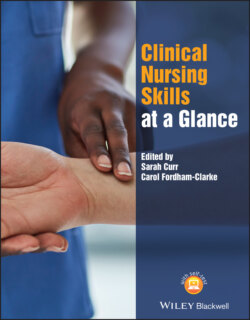Читать книгу Clinical Nursing Skills at a Glance - Группа авторов - Страница 18
Оглавление7 Informed consent
Figure 7.1 Implied consent.
Figure 7.2 Translation material.
Figure 7.3 Materials in Braille.
Figure 7.4 Written consent with signature.
Background
Part 4 of the Nursing & Midwifery Council (NMC) code highlights the need for informed consent to be obtained – 4.1 specifically states that we must “act in the best interests of all people at all times”, recognising “that we need to respect a person's right to accept or refuse treatment” (NMC 2018, p. 7).
For a person's rights to be respected we must ensure that they have all key information in order to be able to make an informed decision about accepting or refusing treatment.
This informed consent can then be given in written or oral form, but it can also be implied, such as when providing the arm for blood pressure measurement (Figure 7.1).
In healthcare, informed consent must be achieved for all interventions and this includes initial and ongoing assessments, tests, treatments, and subsequent care provision.
It is important to note that informed consent is only valid for the period of that intervention. If that interaction is repeated, consent will need to be obtained again. This is required for all healthcare interventions.
Influencing Factors
Language barriers – these can be mitigated by using translated material and translation services (Figure 7.2).
Visual impairment – ensure that the patient has all usual visual aids and consider whether larger text may be available for written material. Written material is also available in braille (Figure 7.3).
Aural impairment – ensure that the patient has all hearing aids and that these are working effectively. Consider whether a quieter area would be more appropriate to provide the information. The patient’s wish for privacy and dignity must also be taken into consideration here.
Inability to communicate – there are multiple communication tools available and patients will often have their own, so most communication challenges can be overcome. In the case of an unconscious patient, consent cannot be obtained and healthcare professionals are required to act in the best interests of the patient.
Lack of capacity – if a lack of capacity is suspected this must then be tested.1
Professional Approach
The healthcare professional who is gaining consent must ensure that they understand the information being given, are able to answer relevant questions on the topic (Royal College of Nursing 2017), and have time to undertake the task.
To ensure informed consent, the healthcare professional must provide all key information, answer questions, and then ascertain understanding by asking questions to ensure that the information has been retained and recalled.
Consent must be gained voluntarily from the patient. If the patient is influenced by other healthcare professionals, family, friends, or significant others, it is our duty to report this to the multidisciplinary team caring for the patient.
Remember that, although informed consent is a professional requirement, it is also a legal requirement. Withholding key information which then results in harm can result in a claim of negligence by omission (Montgomery v. Lanarkshire Health Board 2015).
Equipment
Ensure that you have all relevant material, i.e. written material, translator service.
Ensure you have an appropriate space to gain the consent.
Procedure – Informed Consent
Introduce yourself and advise that you are gaining consent for the required procedure. For many procedures, you explain the procedure you are doing and ask if they consent to this. The detail required will depend on the complexity and risks of the procedure: e.g. surgery requires detailed information to be provided and written consent.
Confirm the patient's name, date of birth, and other identifiers as required by local Trust policy.
Explain the nature of the procedure.
Explain why the procedure is being proposed.
Highlight the risks of the procedure.
Provide information on the benefits.
Advise what will happen if the procedure is not performed, and what the prognosis will be.
Avoid using medical jargon and check for understanding after each stage of the process.
Provide the patient with adequate time to absorb the information given and read all written material.
Return to obtain informed written consent, with a signature (Figure 7.4), and file this appropriately within the patient’s notes.
Red Flag
Using a family member to translate could result in the full information not being provided to the patient. This would not be valid consent and the healthcare professional could be held to account in the event of an adverse outcome.
Do not assume that there is a lack of capacity because you feel that the decision is unwise. This could result in charges of battery (Dimond 2015).
References
1 Dimond, B. (2015). Legal Aspects of Nursing, 7e. Harlow: Pearson.
2 Mental Capacity Act 2005 (c.9). https://www.legislation.gov.uk/ukpga/2005/9/contents
3 Montgomery v. Lanarkshire Health Board (2015) UKSC 11. https://www.supremecourt.uk/cases/docs/uksc‐2013‐0136‐judgment.pdf
4 Nursing & Midwifery Council (2018). Professional Standards and Practice of Behaviour for Nurse, Midwives and Nursing Associates. London: Nursing & Midwifery Council.
5 Royal College of Nursing (2017). Principles of Consent: Guidance for Nursing Staff. London: Royal College of Nursing.
Note
1 1 The healthcare professional must ascertain that the person has an impairment, which means that they cannot do one or more of the following: (i) understand information presented; (ii) retain information sufficiently to make a decision; (iii) weigh up the information provided; (iv) communicate their decision (Mental Capacity Act 2005).
